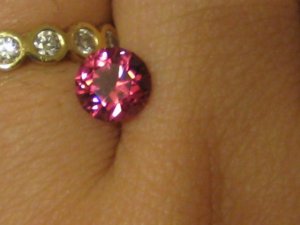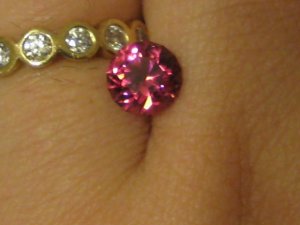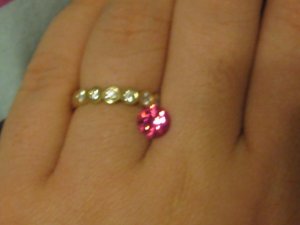- Joined
- Mar 2, 2009
- Messages
- 13,279
Fly Girl|1300936965|2878671 said:Pretty stone. It's my understanding that a rubellite holds its color in different lighting. You'd have to ask Barry, but if he doesn't call it a rubellite, it probably isn't.
Chrono|1300968053|2878782 said:Just about a marketing names these days but that doesn't help the poor regular consumer, doesn't it? As long as it shows some red, it's a rubellite, hence the meaning of the name "ruby like". Red is a dark toned pink. Whether it holds its colour or not is altogether a different matter.
Chrono|1300968053|2878782 said:Just about a marketing names these days but that doesn't help the poor regular consumer, doesn't it? As long as it shows some red, it's a rubellite, hence the meaning of the name "ruby like". Red is a dark toned pink. Whether it holds its colour or not is altogether a different matter.
Take a look at it in incandescent or other indoor lighting. It may tend to go brown.MakingTheGrade|1301021237|2879676 said:Barry tends to shy away from the "marketing" terms, which I appreciate as it makes things less confusing. He typically just lists the stone type, and sometimes the location if he knows it.
When I asked him, he said it looks amazing in natural light. What kind of lighting does most tourmaline lose its color in?
I don't really place much importance in the labels, I just bought it because the color jumped at me, but I was still curious.
Fly Girl|1301061069|2879933 said:Take a look at it in incandescent or other indoor lighting. It may tend to go brown.MakingTheGrade|1301021237|2879676 said:Barry tends to shy away from the "marketing" terms, which I appreciate as it makes things less confusing. He typically just lists the stone type, and sometimes the location if he knows it.
When I asked him, he said it looks amazing in natural light. What kind of lighting does most tourmaline lose its color in?
I don't really place much importance in the labels, I just bought it because the color jumped at me, but I was still curious.
Another link on the subject--
http://www.gemselect.com/other-info/about-rubellite.php
tourmaline_lover|1301062187|2879945 said:Did he say how it looks in incandescent light? Flygirl is correct as pink/red family tourmalines tend to "brown out" in incandescent light.
Michael_E|1301073574|2880126 said:tourmaline_lover|1301062187|2879945 said:Did he say how it looks in incandescent light? Flygirl is correct as pink/red family tourmalines tend to "brown out" in incandescent light.
I wasn't sure that I believed this and so got out a box of rough pinks and red tourmalines and had a look. The end result is that you're right , some of them do turn brownish under incandescent light. After a bit of messing around with this it turns out that those pink/red tourmalines which turn brownish to some degree are those which have a green tint, typically on the A-B axis. The increased red/orange color in the incandescent light interacting with the green component in the gem is perceived by our eyes as brown. Cool. I think that the reason that most rubellite's don't turn brown is that they have the same colors on all axes or pale cross axes and so any brown just gets overwhelmed by the increased red displayed in incandescent lighting. The downside is that I have a few distinctly greenish cross axis pink tourmalines that just became mineral specimens.
Thanks for the observations, Michael. That makes a lot of sense.Michael_E|1301073574|2880126 said:tourmaline_lover|1301062187|2879945 said:Did he say how it looks in incandescent light? Flygirl is correct as pink/red family tourmalines tend to "brown out" in incandescent light.
I wasn't sure that I believed this and so got out a box of rough pinks and red tourmalines and had a look. The end result is that you're right , some of them do turn brownish under incandescent light. After a bit of messing around with this it turns out that those pink/red tourmalines which turn brownish to some degree are those which have a green tint, typically on the A-B axis. The increased red/orange color in the incandescent light interacting with the green component in the gem is perceived by our eyes as brown. Cool. I think that the reason that most rubellite's don't turn brown is that they have the same colors on all axes or pale cross axes and so any brown just gets overwhelmed by the increased red displayed in incandescent lighting. The downside is that I have a few distinctly greenish cross axis pink tourmalines that just became mineral specimens.
blithesome71|1301144996|2880651 said:hmmm, this might be an additional reference:
http://www.gemstone.org/index.php?option=com_content&view=article&id=111:sapphire&catid=1:gem-by-gem&Itemid=14
"...There are red and pink tourmalines in many nuances, which include a tender pink, a fine shocking pink, an intense violet and a bold ruby-red. However, only a few of these are entitled to call themselves 'rubellites'. The name comes from the Latin 'rubellus', which means reddish. Rubellites are not merely red or shocking pink tourmalines. There is an important criterion for this especially beautiful gemstone, and that is the way its colour behaves in daylight and artificial light. Many gemstones change their colour depending on the light source. A true rubellite does not. It shines just as intensely in artificial light as it does in daylight. The colour of most other pink or red tourmalines, by contrast, displays a more or less clearly visible tinge of brown in artificial light."
Chrono|1301316933|2881739 said:This is why I often stress, "buy the stone", not buy the name. I've seen too many pinkish red tourmalines that do NOT hold their colour being advertised and sold as rubellites.



ForteKitty|1301358350|2882216 said:oh man, what have you done to me?! i've been soooo good, staying away from Barry's drops.. and this lusciousness is luring me back in!! NooooOOooooo!!
but seriously, it's one gorgeous tourmaline. 3 stone all the way!
